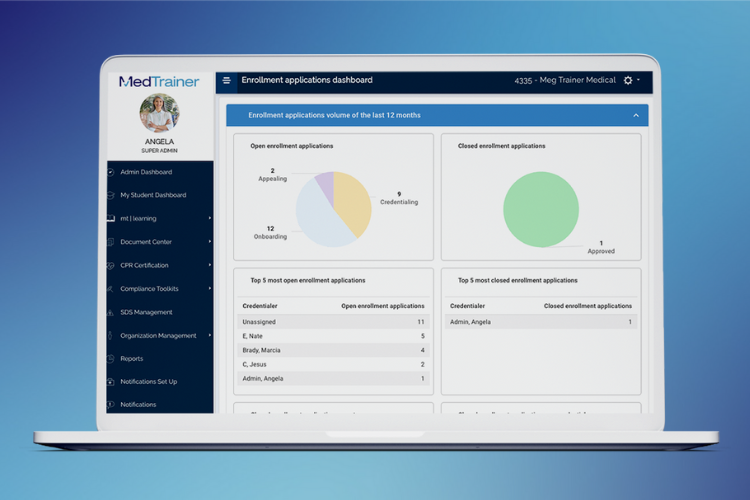Provider enrollment and credentialing are two terms often used when onboarding a new healthcare provider. It’s often assumed that these terms mean the same but they’re two separate onboarding processes that are somewhat intertwined with one another. So, what is the difference between provider enrollment and credentialing?
In this blog, we’ll discuss the two processes and key differences between provider enrollment and credentialing. We’ll also review why both processes are vital for healthcare organizations.
What is Provider Enrollment?
Provider enrollment is when a healthcare provider is registered with insurance networks or government payers, like Medicaid or Medicare. This process typically involves submitting an application with detailed information regarding the provider’s qualifications and licenses. Information about the employer’s Taxpayer Identification Number (TIN), practice location, and protocol agreements are also needed.
After the insurance network verifies and approves the application, the provider becomes an approved network provider. The provider is eligible to receive reimbursement from the insurance company for services provided during a patient’s visit. Provider enrollment confirms the healthcare provider meets and maintains certain compliance standards for the insurance or payer network.
Watch this on-demand webinar to get tips to speed up your enrollment process.
What is Provider Credentialing?
Provider credentialing entails verifying a healthcare provider’s qualifications and competency to deliver services. This process is often completed by the healthcare organization and is similar to a quality assurance procedure.
During provider credentialing, the healthcare organization verifies the provider’s education, work history, licenses, references, and other vital information. The employer may also review any pending and past medical malpractice cases or disciplinary actions. Additionally, the organization confirms the provider adheres to professional and quality standards outlined by government regulations and accrediting bodies.
Once the provider’s credentials are approved t, they’re eligible to bill for medical services. However, the healthcare organization now begins the provider enrollment process to receive insurance reimbursements.
Watch this on-demand webinar to get tips to speed up your internal credentialing process.
What Is the Difference Between Provider Enrollment and Credentialing?
Provider enrollment and credentialing are similar in some ways but there are key differences:
- Compliance Standards: Provider enrollment ensures the provider meets the insurance network’s compliance standards. Provider credentialing confirms their eligibility to bill for services under government and accreditation regulations.
- Required Information: Provider credentialing focuses on the provider’s education, training, and licensure. Provider enrollment requires most of this information in addition to information regarding their employment terms and practice location.
- Timeline: Healthcare organizations typically must complete the provider credentialing process before beginning provider enrollment. Often, credentialing is a prerequisite for insurance network provider or payer enrollments. The credentialing process takes a few weeks, while the enrollment process can take several months.
- Outcome: Provider credentialing confirms a provider’s qualifications. Provider enrollment allows the provider to offer services for a specific insurance company or government payer.
| Provider Enrollment | Provider Credentialing | |
| Compliance Standards | Provider enrollment ensures the provider meets the insurance network’s compliance standards. | Provider credentialing confirms their eligibility to bill for services under government and accreditation regulations. |
| Required Information | Provider enrollment requires most of this information in addition to information regarding their employment terms and practice location. | Provider credentialing focuses on the provider’s education, training, and licensure. |
| Timeline | Several months and is completed after credentialing. | Several weeks. Credentialing is often a prerequisite for insurance network provider or payer enrollments. |
| Outcome | Provider enrollment allows the provider to offer services for a specific insurance company or government payer. | Provider credentialing confirms a provider’s qualifications. |
Provider Enrollment and Credentialing Are Both Vital
Provider credentialing and enrollment are essential to the onboarding process. Here are some of the reasons why:
- Meet Reimbursement Standards: Both processes verify that a provider is eligible to bill for services rendered and it’s how the healthcare organization gets paid. It involves confirming the provider has completed the education and licensure requirements versus insurance company standards.
- Verify Compliance: Each involves verifying a provider has met compliance standards. This helps uphold quality healthcare standards and protects against fraud, waste, and abuse.
- MaintainsInformation Accuracy: Provider credentialing and enrollment require that providers and healthcare organizations maintain and regularly update their information including provider licenses, practice locations, and compliance standards. The information confirms a provider is currently licensed to practice medicine.
- Authorize Services Rendered: Provider enrollment confirms insurance companies or payers agree to the scope of services rendered by a particular healthcare provider. Credentialing verifies the provider has the education and experience to render these services. State and federal regulations require both processes for authorization to bill for services.
- Reduce Costs: Following government and insurance networks’ rules and regulations helps manage healthcare costs. Complying with laws regarding fraud, waste, and abuse also helps to reduce unnecessary expenditures.
The credentialing process can be quite cumbersome and time-consuming as it involves thoroughly verifying a provider’s information and qualifications. For many healthcare organizations, this is a manual and tedious process that can sometimes lead to errors or misentered information. Using credentialing software, like MedTrainer, can help streamline the provider credentialing and enrollment process. This can potentially decrease the amount of manual processes, and in turn, increase efficiency and reduce potential errors.
Complete credentialing 3 weeks faster

